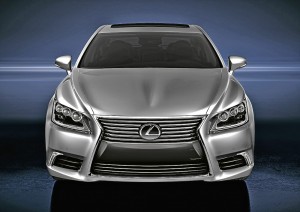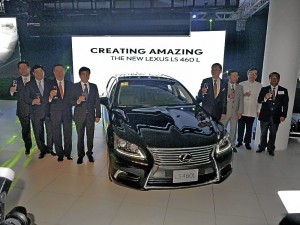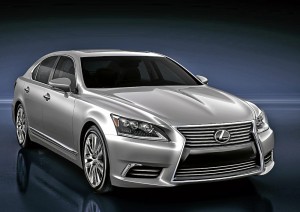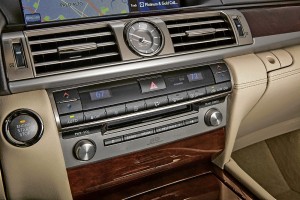Lexus Manila launches new LS 460L flagship sedan
Lexus Manila just took the wraps off its new flagship, the LS 460L ultra-luxury sedan. The 2013 LS carries the brand’s new design language, as well as a whole boatload of convenience and comfort features. It also has a strong hint of something that has only recently been introduced throughout the Lexus lineup—a dash of sportiness.
That aspiration to being a more athletic and responsive automobile is made manifest in the LS’s new nose. The brand’s new trademark, the hourglass-shaped “spindle grille,” makes its way to the flagship large sedan. The aggressive new front merges well with the sleek, minimalist lines of the rest of the car. The high-technology content of the car is accentuated via the available all-LED exterior lighting. Aside from the prominent badge, more Ls are in the headlamp clusters—the daytime running lights dubbed seamless light tubes.
Lexus says that the body rigidity has been improved via laser welding and adhesive body bonding techniques. A rigid chassis is essential to good handling as well as a comfortable ride. Enhancing the ride comfort further are adaptive-damping shock absorbers or adaptive air suspensions. Roll, pitch, and bounce are well-controlled to enhance handling feel. The steering has reportedly been improved for better turn-in response, and the brakes, too, offer better pedal feel. A first for the LS, the suspension damping can be switched via a center console knob to any of five modes: Eco, Comfort, Normal, Sport S, or Sport S+, spanning the range from a soft, economical response, to a more aggressive driving response.
This wouldn’t be a Lexus without the trademark quietness. Special effort has been made to cut road, engine, and wind noise. Even the alloy wheels feature hollow chambers, which are

SUITED FOR THOSE IN SUITS The traveling executive should like the over 3000 changes, including three world first technologies and 15 Lexus firsts, that the LS460L boasts.
designed to reduce noise transmission to the cabin. For the LS, climate control is not enough; the car features a Climate Concierge that monitors front and rear seat areas via up to 13 sensors dotted throughout the cabin. 20 air outlets, as well as seat coolers built into the front chairs, allow the cabin to cool rapidly to attain a comfortable temperature. Air purification is accomplished with “nanoe” ions that eliminate odors as well as prevent overly dry air.
Article continues after this advertisementTaking a cue from traditional Japanese craftsmanship, the new three-spoke steering wheel, as well as the dashboard wood panels, is available in Shimamoku finish. Shimamoku or “striped wood” involves layering and angled cutting of wood veeners, taking up to 38 days to finish. On the dashboard is an analog clock that auto-synchronizes via the GPS system. Above the clock is a monitor to make an iPad envious: a 12.3-inch LCD screen that can split its display to show two information sources such as map/audio, and night view/map. The system accepts input via a slide haptic joystick—a mouse-like device that allows quick scrolling across the menus.
Article continues after this advertisementShattering the cathedral-like silence is the concert-hall like sound of the Mark Levinson audio system. 19 loudspeakers, including 12 speakers unique to the LS, are powered by amplifiers with less than 0.1 percent Total Harmonic Distortion, and produce 450 watts of sound. The system is designed as a 7.1 channel surround setup. The rear seats contain 9-inch VGA screens taking input from either an SD card, or a Blu-ray player. Other hedonistic touches include in-car refrigerator, retractable table, and seat massagers—with a choice of acupressure or Shiatsu programs. If you opt for the four-seat version of the LS, the rear seats become power-operated recliners with ottoman thigh and footrest.

LEXUS Manila chair Alfred Ty (fourth from left), Socco and Isla lead a toast for the arrival of the Lexus 460L at the Lexus showroom at the Bonifacio Global City.
Although them 200-inch super-sedan may seem designed to provide a first-class ride to the fellows in the back seat, the LS retains some treats for the enthusiast driver. By twisting the center-console knob from Comfort or Eco to Sport or Sport S, one transforms the LS’ response. The Sport modes make the throttle more responsive, while the Sport S+ mode reduces body roll via programming of the adaptive dampers. Steering response quickens as well.
The LS is powered by a 4.6-liter V8, capable of 387 hp and 493 Nm. The engine mates to an 8-speed automatic transmission. 0-100 kph zips by in 5.7 seconds, and top speed is an electronically-controlled 250 kph.
Key to the Lexus experience is quality, and the company reportedly outdid itself here. Laser welding reduces vibration of the body shell. Panel gaps are checked thoroughly, and all assembled parts are measured during final inspection. Paint undergoes polishing after each coat, and hand-polishing of the entire foundation coat before the final clear coat process. The paint robots’ program was based on the hand-spraying techniques of a master craftsman. Each vehicle undergoes a vibration test, as well as a full driving test to check all systems before release.
This perfectionist approach leads to the brand’s mantra of “satisfaction guaranteed.” Daniel Isla, president of Lexus Philippines, said, “While our goal is to become the most desired
premium brand in the market, we know that we must first guarantee your complete satisfaction.”
Hideki Watanabe, chief engineer of the LS, said, “At the start of the LS development program, I had to consciously broaden my horizons, focusing on the finer things in life from the worlds of art, design and technology-a first step towards creating the most sophisticated LS yet to satisfy the world’s most discerning customers.”
The LS 460L 5-seater retails for P7.388 million while the four-seater version goes for P8.378 million.
With over 3000 changes to this flagship car, including three world first technologies, and 15 Lexus firsts, the LS is indeed more.

